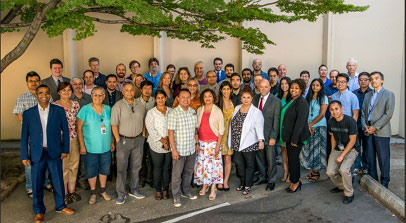By Phil Frisbie, Jr.
District 1 Chief Public Affairs Officer

These people did some of the heavy lifting in making Caltrans’ external-facing website ADA compliant.
Photo by District Headquarters
On June 28, Caltrans switched all public web pages to a new template that is more accessible to all users as part of our Caltrans Web Accessibility for All (CWAA) project. The change is the culmination of months of planning, hundreds of hours of meetings and training, and thousands of hours of labor statewide.
Why did we need to do this? The July 1 deadline was the result of California legislation, AB 434, signed into law in October 2017. However, all government agencies receiving federal funding, which includes Caltrans, have been under obligation to follow Section 508 of the Rehabilitation Act of 1973 since it was passed in 1998, more than 20 years ago.
Caltrans’ information technology (IT) personnel worked to ensure that all the department’s web content that has been legislatively mandated or deemed mission critical would be posted by July 1. Efforts are ongoing to post other documents that may have a public interest.
Most users of our website will only notice the new template, which provides the look and feel of the pages. Not only does the new template better meet ADA (Americans with Disabilities Act) requirements for those with disabilities, it also provides a better experience for the ever- increasing number of users accessing our site from mobile devices. The previous template was about 12 years old, and standards have changed significantly during that time.
The CWAA project comes with many standards and guidelines. However, if you create documents that are posted to the web and have taken some of the ADA training, then you may have already realized that the big change is not technical, it is cultural.
Employees who create web documents must think about accessibility as they are writing them, and not as an afterthought, because it takes much longer to fix (remediate) the document after the fact than taking the time to do it as it is being written.
It also means that we are now evaluating what documents really need to be posted, or if information is better posted as a web page (which is easier to make compliant) rather than a PDF, as we would have automatically done in the past.
This cultural change is just beginning. All state agencies were required by law to bring their public websites and documents up to current ADA accessibility standards by July 1. However, Caltrans will now be looking to bring our internal websites (Intranet/Onramp) and internal documents up to current accessibility standards to better serve our own employees who have disabilities.
There are no time frames yet, but all employees who create documents would be wise to check out the CWAA Intranet site at cwaa.onramp.dot.ca.gov.

